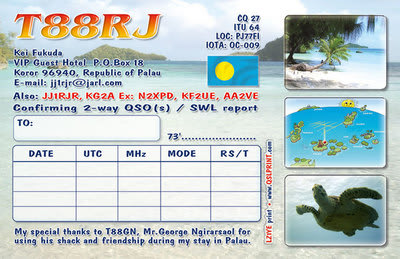日本でも最近は石のリニアが流行りつつありますが、と言っても日本製の最先端リニアにはおめにかかれず自作するしかなさそうですが....
さて、とあるメーリングリストで紹介されていたVE7OJ/AB4OJ Adamによるパワーアンプを長持ちさせる為の当たり前のお約束事9箇条、参考に和訳しておきます
1.フルパワーでATU(内蔵および外部オートマティックチューナー)をチューンしないこと。
常時、送信機の出力を正確なチューニングのために必要な最低出力まで落とすこと。チューニングが完全に取れた後に必要なレベルまでパワーを上げる。
2.SWRがマッチングしていない状態(SWR1.5以上)で運用しないこと。リニアにダメージを当ること以外に、リニアに複雑な負荷がかかることで送信のIMD特性に影響を与える。これにより近隣で運用する人には好ましくない環境となる。
3.複数のATU(内蔵ATUおよび外部マニュアルチューナーまたはATU)を決して同時接続しないこと。チューナーをふくすう接続はは内部チューナー、ローパスフィルターおよびリニア終段部の部品を破壊する可能性がある。
4.送信中にVFOを動かさないこと。これは送信規則に抵触するということだけでなく、送信機の部品破壊、特にアンテナシステムでのインピーダンスの凹凸があった場合またはレンジの境界を越えることでローパスフィルター選択リレーがホットスイッチになることことを避けるためです。
5.外部リニアアンプを使用するときは、常時ALCを接続してアンプの出力が適切な水準になるように設定すること。
6.最初の調整は常に送信出力を50オームのダミーロードにつないですること。これにより不必要な信号を送信することを避けるられる。
7.チューンしていない状態でグリッドドライブの真空管式アンプをドライブする場合、30MHzのローパスフィルターを送信機とリニアの間に接続すること。これによりリニアからVHFの規制発振があった場合に、送信機をダメージから回避させることができる。
8.カスケードドライブの真空管式アンプをドライブする場合、チューンされた入力ネットワークが1.5:1以下(場合によっては、あっても2:1以下)のVSWRで使用する各バンドで整合していること。これにより、送信機の出力およびアンプの入力間のATUの必要性を未然に防ぐ。大きくチューンされていないアンプの入力部と釣り合わせるために送信機のオートチューナーを利用することは、送信機の終段部、ローパスフィルターおよびATUに危険なほどに高電圧・高電流を発生させ、最悪の部品の損傷をもたらす可能性がある。
9.ソリッドステートの送信機で、比較的遅いオープンフレームT/Rリレーを装備した古い真空管式のアンプをドライブする場合は、送信機は送受信の切り替えを行うときに短時間終端されていない状態にある。このため、この種類のリニアを使うときは送信機内蔵のATUは常にOFFにしておくべきである。
*YaesuのVL-1000のATUは適切なチューンのために約75Wの出力が必要。通常のトランシーバーのATUは適切にチューンするために5-10Wの出力が必要。外部チューナーを使う場合は、マニュアルまたはオートチューナーにかかわらず10Wからチューンを始めるのが安全。
†アンテナに接続している場合。
今更ですがまとめてあるとそれなりに含蓄があるかな
原文はこちら
http://www.ab4oj.com/quadra/rules.html
1. Do not tune your ATU (internal or external) at full output. Always reduce transmitter output to the minimum level required for accurate tuning*. Power can be increased to the desired level once the best match has been achieved.
2. Do not operate with a poor match (VSWR > 1.5). Apart from the risk of damage, the complex load presented to the PA will degrade the transmitter's IMD performance. This is not a kindness to your neighbours on the band.
3. Never cascade ATU's (internal autotuner and external manual or automatic tuner.) Cascading tuners can lead to component failure in the internal tuner, the low-pass filters and/or the PA stage.
4. Do not "sweep" the VFO whilst transmitting. This is not only in breach of radio regulations†; it can also cause component failure in the transmitter, especially if you sweep across an impedance "bump" in the antenna system or across a range boundary causing LPF selection relays to hot-switch.
5. When using an external amplifier, always connect and configure the ALC line to level the amplifier's output at its design rating. This is especially true of a solid-state amplifier.
6. Initial adjustments should always be performed with a 50-ohm resistive load at the transmitter output, to avoid radiating unwanted test signals.
7. When driving a grid-driven (grounded-cathode) tube amplifier with an untuned, swamped input circuit, place a 30 MHz low-pass filter in the coax between the exciter and amplifier. This will protect the exciter from damage in the event of a VHF parasitic oscillation in the amplifier. Solid-state exciters are especially vulnerable in this respect.
8. When driving a cathode-driven (grounded-grid) tube amplifier, ensure that the tuned input networks present a load with VSWR < 1.5:1 (if possible, but in any case < 2:1) to the exciter over each band in use. This will obviate the need for an ATU between the exciter output and amplifier input.Use of the exciter's autotuner to compensate for a grossly mis-tuned amplifier input network can generate dangerously high voltages and currents in the exciter's PA stage, LPF and autotuner, leading to catastrophic component failure.
9. When a solid-state exciter drives an older tube amplifier fitted with relatively slow open-frame T/R relays, the exciter is unterminated for a brief interval during the RX/TX transition. For this reason, the exciter's internal ATU should always be disabled when driving this type of amplifier. Any tuned input networks should be aligned to present a 50Ω load to the exciter at midband on each band. If the exciter has variable RF onset delay, this should be adjusted to allow for relay settling time. The best solution is to retrofit the amplifier with vacuum relays.
* The Quadra autotuner requires approx. 75W for correct tuning. A typical transceiver's autotuner will tune correctly with 5 ~ 10W. When using an external manual ATU, 10W is a safe starting point.
† when feeding an antenna
さて、とあるメーリングリストで紹介されていたVE7OJ/AB4OJ Adamによるパワーアンプを長持ちさせる為の当たり前のお約束事9箇条、参考に和訳しておきます
1.フルパワーでATU(内蔵および外部オートマティックチューナー)をチューンしないこと。
常時、送信機の出力を正確なチューニングのために必要な最低出力まで落とすこと。チューニングが完全に取れた後に必要なレベルまでパワーを上げる。
2.SWRがマッチングしていない状態(SWR1.5以上)で運用しないこと。リニアにダメージを当ること以外に、リニアに複雑な負荷がかかることで送信のIMD特性に影響を与える。これにより近隣で運用する人には好ましくない環境となる。
3.複数のATU(内蔵ATUおよび外部マニュアルチューナーまたはATU)を決して同時接続しないこと。チューナーをふくすう接続はは内部チューナー、ローパスフィルターおよびリニア終段部の部品を破壊する可能性がある。
4.送信中にVFOを動かさないこと。これは送信規則に抵触するということだけでなく、送信機の部品破壊、特にアンテナシステムでのインピーダンスの凹凸があった場合またはレンジの境界を越えることでローパスフィルター選択リレーがホットスイッチになることことを避けるためです。
5.外部リニアアンプを使用するときは、常時ALCを接続してアンプの出力が適切な水準になるように設定すること。
6.最初の調整は常に送信出力を50オームのダミーロードにつないですること。これにより不必要な信号を送信することを避けるられる。
7.チューンしていない状態でグリッドドライブの真空管式アンプをドライブする場合、30MHzのローパスフィルターを送信機とリニアの間に接続すること。これによりリニアからVHFの規制発振があった場合に、送信機をダメージから回避させることができる。
8.カスケードドライブの真空管式アンプをドライブする場合、チューンされた入力ネットワークが1.5:1以下(場合によっては、あっても2:1以下)のVSWRで使用する各バンドで整合していること。これにより、送信機の出力およびアンプの入力間のATUの必要性を未然に防ぐ。大きくチューンされていないアンプの入力部と釣り合わせるために送信機のオートチューナーを利用することは、送信機の終段部、ローパスフィルターおよびATUに危険なほどに高電圧・高電流を発生させ、最悪の部品の損傷をもたらす可能性がある。
9.ソリッドステートの送信機で、比較的遅いオープンフレームT/Rリレーを装備した古い真空管式のアンプをドライブする場合は、送信機は送受信の切り替えを行うときに短時間終端されていない状態にある。このため、この種類のリニアを使うときは送信機内蔵のATUは常にOFFにしておくべきである。
*YaesuのVL-1000のATUは適切なチューンのために約75Wの出力が必要。通常のトランシーバーのATUは適切にチューンするために5-10Wの出力が必要。外部チューナーを使う場合は、マニュアルまたはオートチューナーにかかわらず10Wからチューンを始めるのが安全。
†アンテナに接続している場合。
今更ですがまとめてあるとそれなりに含蓄があるかな
原文はこちら
http://www.ab4oj.com/quadra/rules.html
1. Do not tune your ATU (internal or external) at full output. Always reduce transmitter output to the minimum level required for accurate tuning*. Power can be increased to the desired level once the best match has been achieved.
2. Do not operate with a poor match (VSWR > 1.5). Apart from the risk of damage, the complex load presented to the PA will degrade the transmitter's IMD performance. This is not a kindness to your neighbours on the band.
3. Never cascade ATU's (internal autotuner and external manual or automatic tuner.) Cascading tuners can lead to component failure in the internal tuner, the low-pass filters and/or the PA stage.
4. Do not "sweep" the VFO whilst transmitting. This is not only in breach of radio regulations†; it can also cause component failure in the transmitter, especially if you sweep across an impedance "bump" in the antenna system or across a range boundary causing LPF selection relays to hot-switch.
5. When using an external amplifier, always connect and configure the ALC line to level the amplifier's output at its design rating. This is especially true of a solid-state amplifier.
6. Initial adjustments should always be performed with a 50-ohm resistive load at the transmitter output, to avoid radiating unwanted test signals.
7. When driving a grid-driven (grounded-cathode) tube amplifier with an untuned, swamped input circuit, place a 30 MHz low-pass filter in the coax between the exciter and amplifier. This will protect the exciter from damage in the event of a VHF parasitic oscillation in the amplifier. Solid-state exciters are especially vulnerable in this respect.
8. When driving a cathode-driven (grounded-grid) tube amplifier, ensure that the tuned input networks present a load with VSWR < 1.5:1 (if possible, but in any case < 2:1) to the exciter over each band in use. This will obviate the need for an ATU between the exciter output and amplifier input.Use of the exciter's autotuner to compensate for a grossly mis-tuned amplifier input network can generate dangerously high voltages and currents in the exciter's PA stage, LPF and autotuner, leading to catastrophic component failure.
9. When a solid-state exciter drives an older tube amplifier fitted with relatively slow open-frame T/R relays, the exciter is unterminated for a brief interval during the RX/TX transition. For this reason, the exciter's internal ATU should always be disabled when driving this type of amplifier. Any tuned input networks should be aligned to present a 50Ω load to the exciter at midband on each band. If the exciter has variable RF onset delay, this should be adjusted to allow for relay settling time. The best solution is to retrofit the amplifier with vacuum relays.
* The Quadra autotuner requires approx. 75W for correct tuning. A typical transceiver's autotuner will tune correctly with 5 ~ 10W. When using an external manual ATU, 10W is a safe starting point.
† when feeding an antenna

















